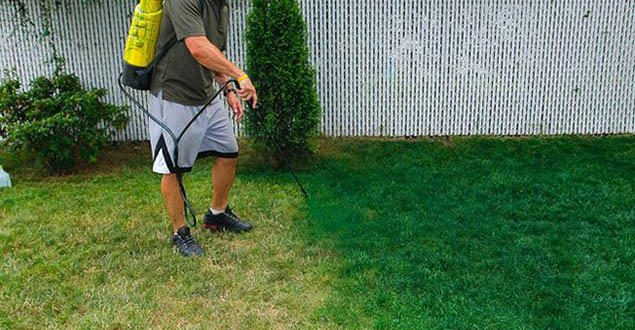Painting the lawn green
Published on September 19th, 2014
September 20, 2014
The Economist
Jack Melligan, a prison guard in Sacramento, was tired of staring at his brown, patchy lawn—a side-effect of the drought that has parched California for the past three years. He thought about replacing it with shop-bought turf, but worried that he might incur hefty fines for watering it, under new statewide water restrictions. So he paid someone $180 to spray-paint his lawn a cheery green instead.
In a state known for special effects, such fakery is to be expected. If Hollywood can make a green screen look like a terrifying desert on an alien planet, it is only natural that Californians should seek ways to make the terrifying deserts in their front yards look verdant. Mr Melligan is not alone; your correspondent has a wardrobe full of green-stained shoes to prove it.
The fad for trompe l’oeil gardening has been a boon for lawn-painters such as David Bartlett, the owner of Xtreme Green Grass, whose business has grown 75% this year. Over the same period Jim Power, who runs a lawn-paint supply company called LawnLift, has seen sales triple. “It has become more socially acceptable to paint your lawn,” he says, “especially as it’s become more socially shameful to water it.” At the same time, fewer Californians are buying new turf, says Jurgen Gramckow, who grows the stuff and says sales at his farm in Oxnard are down 20% this year.
The drought, one of the worst in a century, has pushed the state to waste a bit less water. In July California banned such things as allowing sprinkler water to run off lawns on to streets and washing cars with hoses that have no shut-off nozzle. And on August 29th the state legislature passed three bills that would allow local agencies, for the first time, to curb excessive pumping of groundwater by landowners.
Historically, California has resisted groundwater regulation, favouring local property rights even as every other western state embraced state control. But sentiment has shifted with the realisation that the water might run out. By some measures, the state’s $45 billion agricultural industry already accounts for 62% of water consumption. And it is getting thirstier, as profitable fruit trees and vines have replaced other crops. As surface reservoirs are depleted, farmers are forced to drill deeper. Perhaps 65% of California’s water could come from underground this year, up from 40% in average years, according to the California Water Foundation, a green group. Over-use of wells means that salt water can invade coastal aquifers, and also that fresh water disappears. A recent study by the California Department of Water Resources found that, in about half of the wells surveyed, water levels had already fallen to their lowest point for a century.
Several cities are trying to conserve water. Earlier this year Santa Cruz began enforcing rationing for every home and a ban on filling hot tubs and jacuzzis, with weighty fines and “Water School” for transgressors. The results are striking: in July citywide water use fell 26% compared with last year. In comparison, statewide water use had declined by only 7.5% from the previous year, despite recent pleas from Governor Jerry Brown to all Californians to cut water use by 20%.
The state’s water shortages can be resolved only by putting a sensible price on water. State law will eventually require water metering on all buildings, but not until 2025. “We are finally moving toward a pricing system,” says Barton Thompson, a professor of natural resources at Stanford Law School, “which is really the only way to truly encourage people to conserve.”





